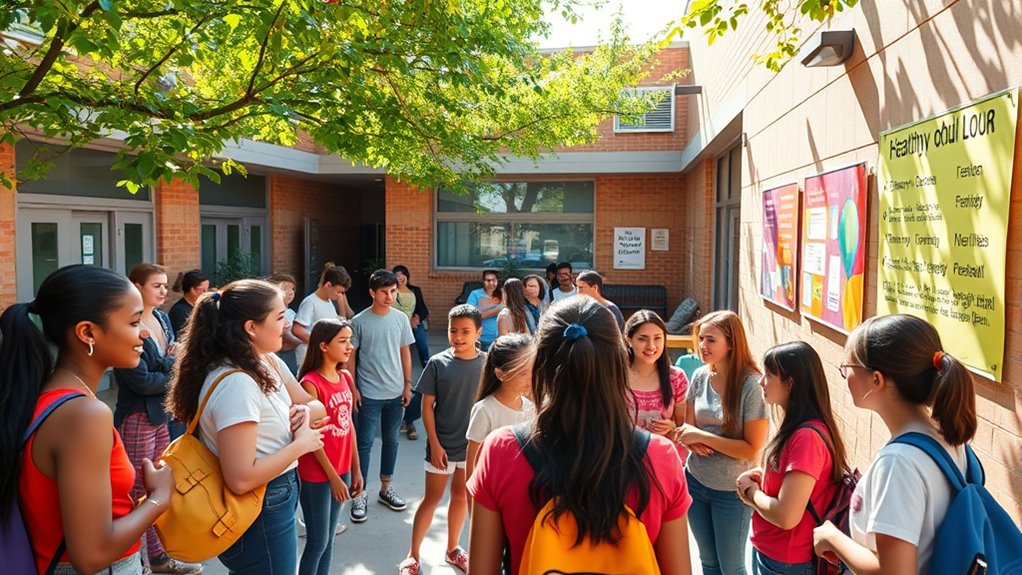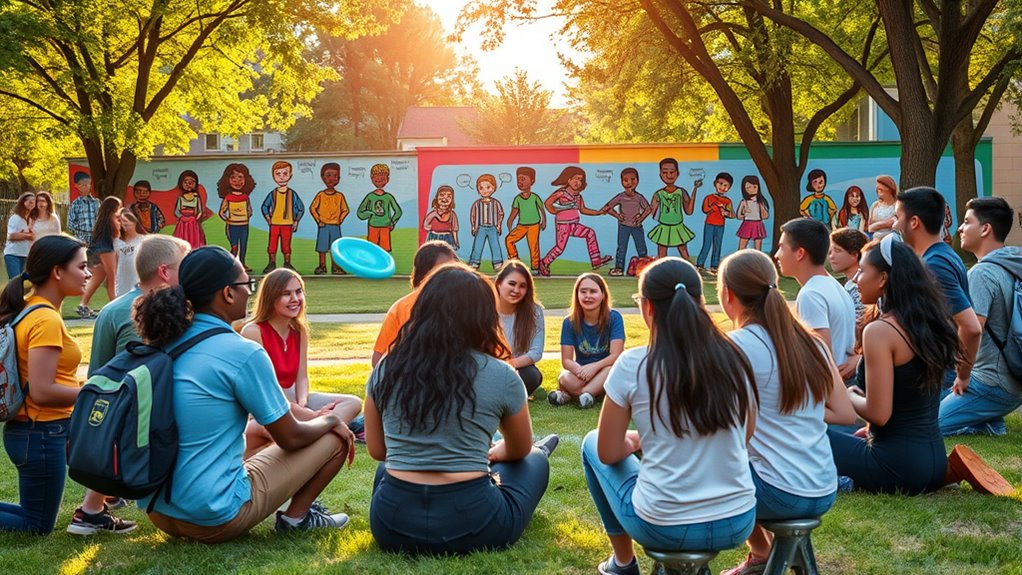Substance use and peer pressure go hand in hand, especially among adolescents. You might feel pressured by friends to try drugs or alcohol, which can affect your decisions and self-esteem. Social media plays a big role too, often glamorizing substance use. Strong family support and effective school programs can help you navigate peer pressure and make healthier choices. By understanding these dynamics, you can build resilience and coping skills that empower your decision-making. There’s much more to explore about these strategies!
Key Takeaways
- Understanding peer pressure dynamics is essential for addressing substance use disorders, particularly among adolescents and college students.
- Social media and celebrities often glamorize substance use, impacting youth perceptions and behaviors.
- Evidence-based school programs, like Project ALERT, effectively teach drug resistance and coping skills.
- Strong family support and open communication foster resilience against peer pressure and risky behaviors.
- Engaging in community initiatives enhances awareness and promotes healthy lifestyle choices among adolescents.
Understanding Peer Pressure and Its Impact on Substance Use

While you may think of peer pressure as something that only affects teenagers, it actually influences various age groups, including young adults. Peer pressure is a powerful social influence that can lead to significant changes in behavior, particularly regarding substance use.
This influence can be direct or indirect, with social cues and perceived norms playing an essential role. Both adolescents and young adults face risks associated with peer pressure, which can either normalize or discourage substance use. Substance abuse is prevalent among college students, and when friends engage in substance use, it often feels acceptable, increasing the likelihood of similar behaviors in others. Understanding this dynamic is critical, as it can contribute to substance use disorders and shape the trajectory of addiction across different age groups.
Factors Contributing to Vulnerability to Peer Pressure

As young people navigate the complexities of adolescence, various factors heighten their vulnerability to peer pressure. The developmental stage itself plays a significant role, as hormonal changes and ongoing brain development can impair decision-making. With the prefrontal cortex still maturing, you might find it hard to resist peer influence. Social environments also shift, making peer groups more influential than family. Psychological factors, like sensitivity to rejection and low self-esteem, increase your need for peer acceptance. Media portrayals of substance use can further normalize these behaviors. Additionally, adolescents are more likely to take risks due to peer influence, which can exacerbate the effects of peer pressure. Impulsivity and poor emotional regulation can amplify your susceptibility, especially if you lack strong family support or stable friendships. Understanding these factors can help you navigate peer pressure more effectively.
The Role of Social Media in Shaping Substance Use Norms

Social media greatly shapes how you perceive substance use, often painting it in a positive light that can influence your choices.
Celebrities and influencers frequently share posts about drugs, normalizing these behaviors for young audiences. A study found that most substance-related content is portrayed positively, while only a small fraction comes from public health organizations warning of risks. This glamorization can lead to social comparison, making you more susceptible to increased likelihood of developing issues with alcohol, tobacco, and cannabis. Furthermore, social media can facilitate access to substances, with platforms allowing direct communication with dealers.
As you scroll through curated feeds, unrealistic comparisons might worsen mental health, increasing the likelihood of turning to substances as a coping mechanism.
It’s essential to recognize these influences and think critically about the content you encounter.
Effective School-Based Prevention Strategies

Effective school-based prevention strategies are vital in addressing substance use among youth. Evidence-based programs focus on building skills like drug resistance, self-regulation, and social abilities.
Effective methods, such as social resistance training and normative education, help students navigate peer pressure. By modulating risk and protective factors, schools play an important role in prevention. Programs like Project ALERT and Project Towards No Drug Abuse have demonstrated success in reducing substance use initiation. To maximize impact, schools should adopt interactive teaching methods tailored to their community’s needs. Creating an Early Intervention/Wellness Team can further enhance the support system within schools. Collaborations with community organizations can enhance effectiveness, while ongoing training for staff guarantees proper implementation.
Ultimately, a positive school climate and strong connections foster healthier development and reduce the likelihood of substance use.
The Importance of Family Support in Mitigating Peer Pressure

Family support plays an essential role in helping adolescents navigate peer pressure, especially during their formative years. Strong family systems can reduce the likelihood of engaging in risky behaviors, such as substance use.
When you maintain open communication and foster positive relationships at home, you build resilience against negative peer influences. The quality of parent-child interactions greatly impacts how adolescents respond to peer pressure.
Active parental involvement helps steer kids away from delinquent peers and encourages healthier choices. Additionally, supportive family environments promote effective coping mechanisms, enabling you to face peer pressure confidently.
Community Initiatives for Drug-Free Alternatives

Community initiatives play an essential role in providing drug-free alternatives for adolescents maneuvering peer pressure. Programs like the Drug-Free Communities Support Program offer grants to local coalitions, helping them promote healthy lifestyles among youth. Additionally, fostering open communication about feelings can enhance the effectiveness of these initiatives.
Project Towards No Drug Abuse equips high school students with crucial resistance skills and decision-making techniques. The Red Ribbon Campaign raises awareness through engaging media and activities, while Community Trials Intervention focuses on reducing high-risk drinking through environmental strategies.
Voices for Prevention educates communities on effective policies for substance abuse prevention. By allocating resources thoughtfully and involving diverse stakeholders, these initiatives create a supportive environment that encourages youth to make healthier choices, steering clear of drugs and alcohol. Additionally, digital literacy programs can foster communication skills that help teens navigate peer pressure effectively.
Positive Peer Influence and Its Benefits

While guiding through adolescence, you might find that positive peer influence can greatly shape your choices and behaviors. Establishing high-quality peer relationships plays an important role in your development, often leading to academic success and prosocial actions.
These positive connections can help protect you from engaging in risky behaviors, including substance use. When you surround yourself with supportive peers, you gain empathy and encouragement—essential elements for maintaining sobriety, especially if you’re in recovery. Additionally, fostering positive relationships contributes to your overall emotional regulation, which is crucial for managing stress and making healthy decisions.
Studies show that having sober friends can greatly reduce the likelihood of relapse. By fostering these positive relationships, you not only enhance your coping skills and decision-making but also reinforce healthy social norms, making it easier to navigate the challenges of adolescence. Additionally, developing strong communication skills fosters deeper connections and enhances the support system among peers.
Resistance Strategies for Adolescents Facing Peer Pressure

Building on the importance of positive peer influence, it’s crucial to equip yourself with effective resistance strategies when faced with peer pressure.
Start by planning ahead; anticipate situations and think of your responses. Assertiveness training through role-playing can boost your confidence in saying “no.” Surround yourself with friends who support healthy choices and engage in community activities that foster positive connections.
Reflect on the consequences of your decisions and reinforce your personal values to strengthen your resolve. Don’t hesitate to seek support from trusted adults or mentors.
Additionally, consider taking breaks from social media to reduce digital pressure. By implementing these strategies, you’ll empower yourself to navigate peer pressure successfully and stay true to your values. Moreover, practicing mindfulness techniques can help you remain centered and focused on your personal goals amidst external pressures.
The Significance of Education in Substance Use Prevention

Education serves as a critical tool in preventing substance use, as it raises awareness about the risks and consequences associated with drugs and alcohol.
School-based prevention programs effectively reduce substance use among youth by providing essential resources and fostering interpersonal connections. These environments allow for early screenings to identify potential issues, helping delay the onset of substance use. Programs targeting students who haven’t yet initiated drug use are especially beneficial.
By promoting social and emotional skills, these interventions empower you to make informed decisions. Successful educational strategies combine life skills training with interactive approaches, correcting misconceptions about substance use.
Ultimately, effective education not only raises awareness but also instills resilience against peer pressure and unhealthy choices.
Building Resilience and Coping Skills for Healthy Decision-Making

Resilience and coping skills are essential for making healthy decisions, especially when faced with peer pressure and challenging situations. By building resilience, you can bounce back from difficulties and adapt to adversity, which reduces the likelihood of substance use. Incorporating continuous learning into your personal development can further enhance your ability to face challenges effectively. Additionally, utilizing SMART criteria in your goal-setting process can provide clear direction and support your resilience-building efforts.
Effective coping skills, such as problem-solving and stress management, empower you to handle emotions without turning to drugs or alcohol. Surrounding yourself with positive peers and engaging in community activities strengthens your support network, making it easier to resist negative influences. Open communication with your family fosters trust and provides guidance, helping you navigate tough choices. Incorporating self-care practices, like mindfulness and exercise, enhances your mental well-being, equipping you to make better decisions in high-pressure situations. Additionally, visualization techniques can help reinforce your commitment to healthy choices and strengthen your resolve against peer pressure.
Frequently Asked Questions
How Can I Identify if My Child Is Experiencing Peer Pressure?
To identify if your child is experiencing peer pressure, watch for changes in their behavior or mood.
Are they suddenly avoiding school or social situations? Notice if they’re more focused on trends or their appearance.
Look for withdrawal from activities they once enjoyed, or shifts in their attitude towards family and friends.
Open communication is key; encourage them to share their feelings and experiences, creating a safe space for them to express concerns.
What Are the Signs of Substance Use in Adolescents?
If you’re concerned about signs of substance use in adolescents, look for changes in behavior and academics.
Notice if they frequently forget homework, skip classes, or lose interest in school activities.
Physically, watch for red eyes, lack of energy, or neglecting hygiene.
Socially, they might become secretive about friends or spend time with new, older peers.
Financially, be aware of sudden money requests or missing items at home.
Trust your instincts and observe closely.
How Does Peer Pressure Differ Across Age Groups?
You might think peer pressure only affects teens, but it’s a powerful force across age groups.
In adolescence, it’s often about fitting in, while emerging adults face pressure to conform to social norms.
As you grow older, the influence shifts; it can encourage healthier choices or lead to risky behaviors.
Recognizing these differences helps you navigate peer dynamics, making it easier to surround yourself with supportive relationships, no matter your age.
Can Positive Role Models Reduce the Effects of Peer Pressure?
Yes, positive role models can greatly reduce the effects of peer pressure. When you look up to someone who makes wise choices, it inspires you to follow suit.
These role models can teach you resilience, boost your self-esteem, and help you set higher educational goals. By surrounding yourself with positive influences, you’re more likely to resist negative pressures and make decisions aligned with your values and aspirations.
What Should I Do if I Suspect My Friend Is Using Substances?
If you suspect your friend is using substances, start by finding a private, calm place to talk.
Approach them with care, using “I” statements to express your concerns without sounding accusatory.
Be prepared for pushback; they might deny it.
Emphasize your support and willingness to help.
Encourage them to seek professional advice if necessary.
Conclusion
In the intricate dance of adolescence, maneuvering through peer pressure can feel like walking a tightrope. By fostering resilience, seeking support from family, and embracing positive influences, you can carve your own path through the storm. Equip yourself with knowledge and effective resistance strategies, and remember that every choice you make is a brushstroke on the canvas of your life. With the right tools, you can paint a vibrant picture, free from the shadows of substance use.









